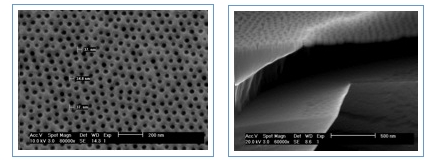Home > Press > R&D Profile: Stimuli-Responsive Polymers in bioMEMS Devices: F. Montagne, Swiss Center for Electronics and Microtechnology, CH
 |
| SEM images of free-standing nanoporous silicon-based membranes: (left) top view showing ∼ 35 nm pores with narrow size distribution and (right) side view of 60 nm thick membrane supported by reinforcement bars. |
Abstract:
Dr Franck Montagne is senior R&D engineer in the department of Nanotechnology and Life Science at the Swiss Center for Electronics and Microtechnology (CSEM), a privately held research and development company which has headquarters in Neuchâtel, Switzerland.
R&D Profile: Stimuli-Responsive Polymers in bioMEMS Devices: F. Montagne, Swiss Center for Electronics and Microtechnology, CH
Cambridge, MA | Posted on June 28th, 2008Stimuli-responsive polymers, also referred to as "smart" polymers, are a very interesting class of materials since they exhibit marked and rapid conformational changes in response to external stimuli such as temperature, pH, electric field or ionic strength. When coated onto a surface, they confer to the resulting materials some unique properties and offer the possibility to achieve control over biocompatibility, wettability or permeability, for instance. Due to their outstanding properties, stimuli-responsive polymers have been attracting considerable attention in biotechnologies and successful applications have already been demonstrated in sensing, intelligent textiles, bio-separation and drug delivery systems. Integration of smart polymers in the fabrication process or in the post-modification of Micro/Nano Electro-Mechanical Systems (MEMS/NEMS) is considered to be a real cornerstone since it allows the introduction of new functionalities to micron/nanoscale silicon-based devices.
In order to illustrate CSEM's activities in this field, we presented at Nanotech 2008 in Boston two examples of real case application of stimuli-responsive polymers in bioMEMS devices. First, we described the fabrication of silicon chips whose surface is modified with poly(N-isopropylacrylamide) (PNIPAM), a thermally-responsive polymer exhibiting a lower critical solubility temperature (LCST) at about 32°C in pure water. Below the LCST, PNIPAM chains are hydrated and form expanded structures in water, whereas they are dehydrated and collapse when temperature is raised above the LCST. In the latter case, it is known that cells adhere and even proliferate on PNIPAM surface, whereas they are progressively released when the temperature is decreased below the LCST. The reversibility of this process was demonstrated in-house with mouse fibroblast 3T3. Based on these results, we produced small silicon chips presenting a pattern of PNIPAM micro-domains of tuneable sizes, typically ranging from 10 μm to 200 μm, for the reversible capture and release of individual cells. These intelligent chips are now integrated into a fully automated cell injection platform equipped with micromanipulator and vision system for high throughput cell transfection.
As a second example, we reported the wafer-scale fabrication of free-standing nanoporous silicon-based membrane having thickness < 100 nm and pore size of about 35 nm (see SEM pictures). These membranes are produced using a CSEM proprietary process combining block copolymer lithography and standard microfabrication techniques. Here, the use of responsive block copolymers permits to precisely control the size and size distribution of the nanopores (typically from few nm to few tens of nm), as well as the final thickness of the membrane. These membranes show remarkable mechanical properties since they withstand a differential pressure of a few bars. The use of these nanoporous membranes for highly selective filtration of biological species and for sensing is currently evaluated at CSEM. First results already show great promises and indicate that nanoporous membranes made from block copolymers self-assembly clearly surpass existing membrane technology (track etched and ultrafiltration membranes) in terms of selectivity and separation rate.
####
About NSTI
For Technology and Informational Services please contact:
Matthew Laudon, Ph.D.
Executive Director, NSTI
Ph: (508) 357-2925
Fax: (925) 886-8461
For more information, please click here
Contacts:
For Technology and Informational Services please contact:
Matthew Laudon, Ph.D.
Executive Director, NSTI
Ph: (508) 357-2925
Fax: (925) 886-8461
Copyright © NSTI
If you have a comment, please Contact us.Issuers of news releases, not 7th Wave, Inc. or Nanotechnology Now, are solely responsible for the accuracy of the content.
| Related News Press |
News and information
![]() Simulating magnetization in a Heisenberg quantum spin chain April 5th, 2024
Simulating magnetization in a Heisenberg quantum spin chain April 5th, 2024
![]() NRL charters Navy’s quantum inertial navigation path to reduce drift April 5th, 2024
NRL charters Navy’s quantum inertial navigation path to reduce drift April 5th, 2024
![]() Discovery points path to flash-like memory for storing qubits: Rice find could hasten development of nonvolatile quantum memory April 5th, 2024
Discovery points path to flash-like memory for storing qubits: Rice find could hasten development of nonvolatile quantum memory April 5th, 2024
MEMS
Announcements
![]() NRL charters Navy’s quantum inertial navigation path to reduce drift April 5th, 2024
NRL charters Navy’s quantum inertial navigation path to reduce drift April 5th, 2024
![]() Discovery points path to flash-like memory for storing qubits: Rice find could hasten development of nonvolatile quantum memory April 5th, 2024
Discovery points path to flash-like memory for storing qubits: Rice find could hasten development of nonvolatile quantum memory April 5th, 2024
Nanobiotechnology
![]() New micromaterial releases nanoparticles that selectively destroy cancer cells April 5th, 2024
New micromaterial releases nanoparticles that selectively destroy cancer cells April 5th, 2024
![]() Good as gold - improving infectious disease testing with gold nanoparticles April 5th, 2024
Good as gold - improving infectious disease testing with gold nanoparticles April 5th, 2024
![]() Researchers develop artificial building blocks of life March 8th, 2024
Researchers develop artificial building blocks of life March 8th, 2024
|
|
||
|
|
||
| The latest news from around the world, FREE | ||
|
|
||
|
|
||
| Premium Products | ||
|
|
||
|
Only the news you want to read!
Learn More |
||
|
|
||
|
Full-service, expert consulting
Learn More |
||
|
|
||








